Aviation
Light Aircraft ( Part 1 )
------------------------------
An airplane relief on airflow over its wings to generate a lifting force, which overcomes
the plane's weight . This airflow is provided by the forward motion of the plane caused
by thrust from the engine. A fin and tail plane stabilize the aircraft in flight. Most light
aircraft use mechanical linkages to transmit the pilot's steering commands to control
surfaces on the wings, fin, and tail plane.
(See diagram shown below : )
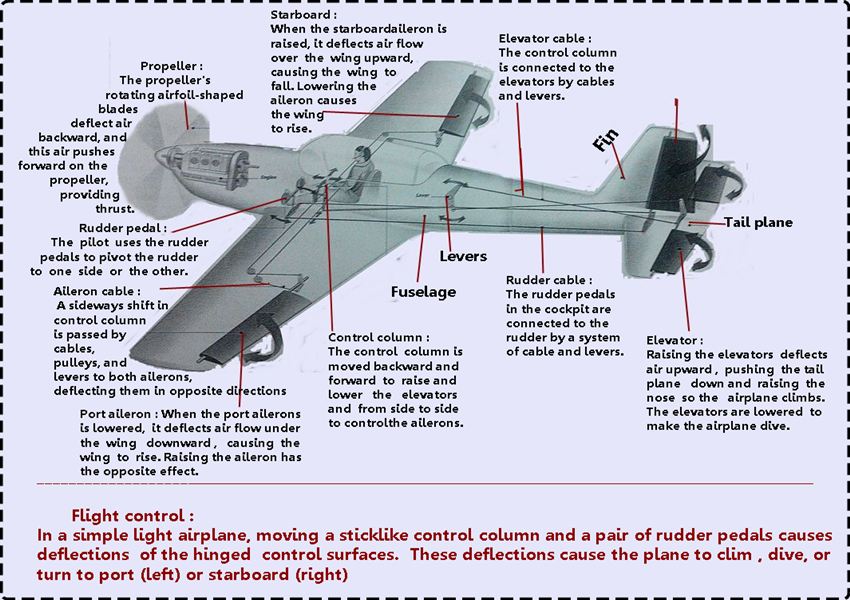
Light Aircraft ( Part 2 )
----------------------------------
Light aircraft are small , relatively simple planes that are used for recreational and
business travel. They are usually powered by piston engines that drive propellers,
although some have jet engines. Unlike large, high-speed aircraft, which have
under-carriage (wheels) that retracts during flight for streamlining, light aircraft
usually have fixed under-carriage to save weight and cost. With the development
of new composite materials, aircraft have become stronger, lighter, and capable of
flying greater ranges.
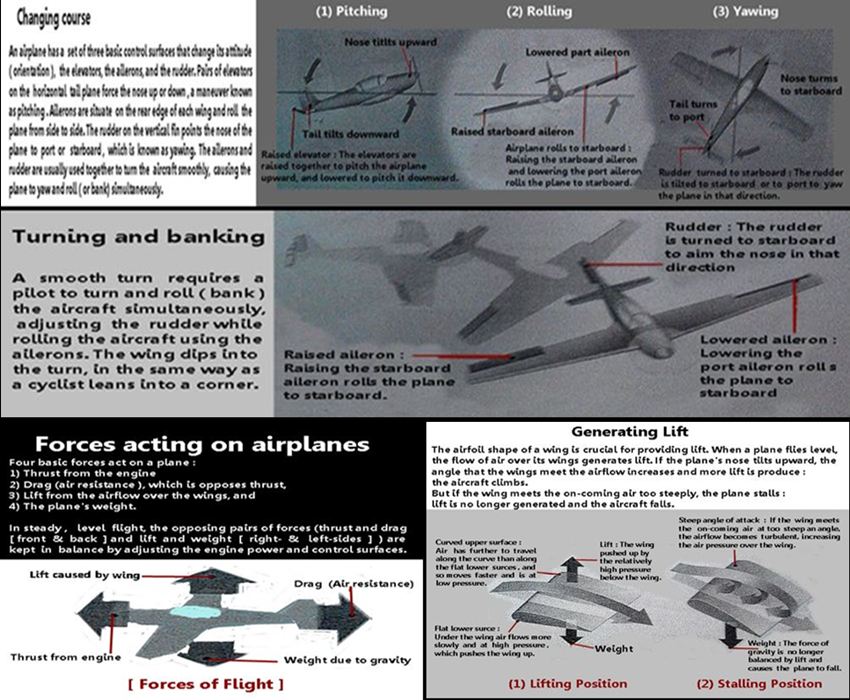
Airliners ( Part 1)
---------------------------
Modern airliners depend on the same aerodynamic principles as light aircraft. However, in order
to meet contemporary standards of safety and comfort and to carry much heavier payloads over
far greater distances, this medium of mass transportation has required huge developments in
instrumentation systems, wing and engine design, and in the material used in their construction.
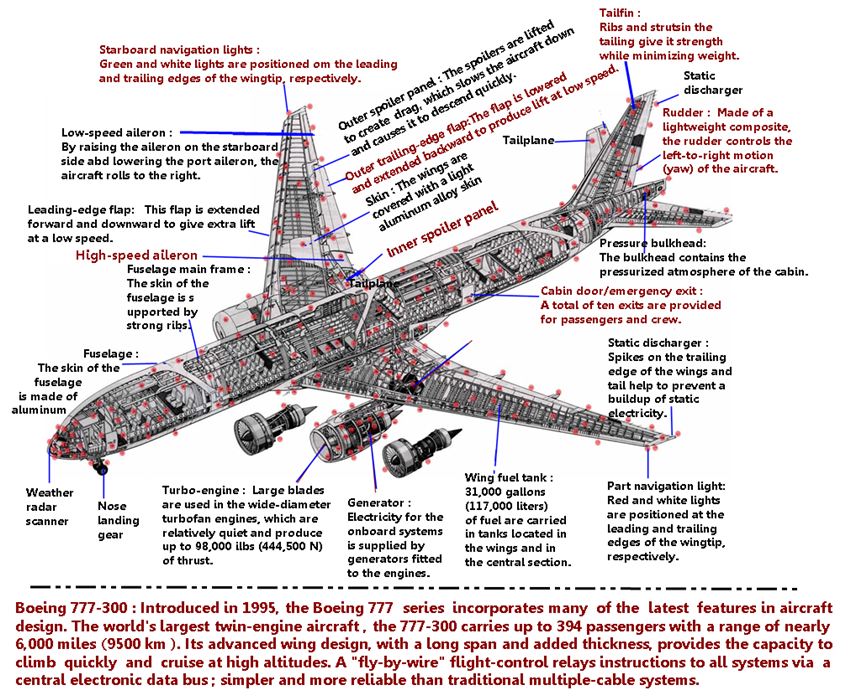
Airliners ( Part 2 )
-------------------------------
The largest passenger-carrying aircraft under development is the Airbus A3XX, which will
carry up to 840 passengers. It will have a takeoff weight of 640 tons (580 tonnes) and a
range of up to 10,000 miles (16,000 km ). In order to propel an aircraft of this size, powerful
engines have been developed. These engines must be fuel efficient in order to meet
anti-pollution standards. The need for fuel economy is one reason why fuel-hungry
supersonic aircraft, such as Concorde, have not become more widely used. It has also
meant that modern aluminum alloys and carbon fiber composites are increasingly used in the
construction of aircraft because they markedly reduce weight and increase strength. Perhaps
the most significant innovation in airliner design has been in control systems. All modern
airliners rely on "fly-by-wire" technology that substitutes the mechanical linkages of traditional
control systems with electronic data lines, and enables complex aircraft to be flown by a crew
of two.
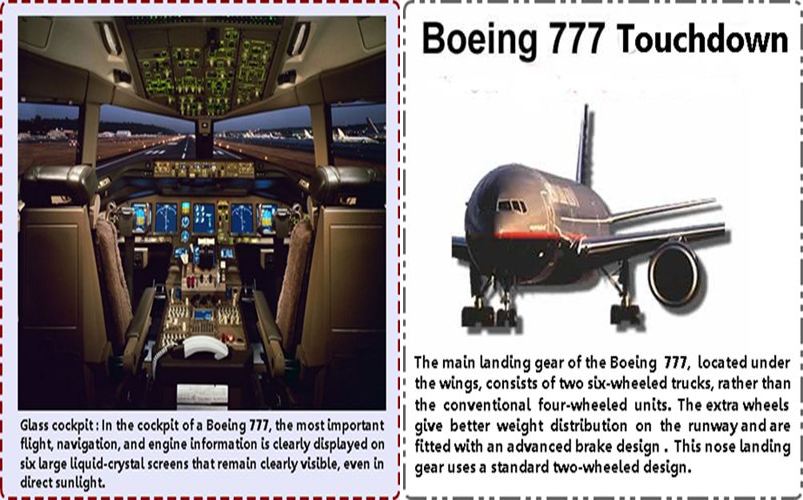
Turbojet Engine (Part 1 )
---------------------------------
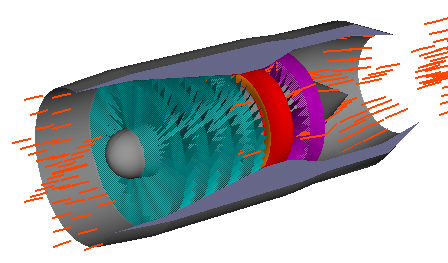
Turbojet engines burn a mixture of air and liquid fuel, in the form of kerosene , to produce
a stream of fast-moving , hot exhaust gases that drives the engine forward. Although
turbojets consume large amounts of fuel and are very noisy, they are extremely powerful
and relatively lightweight, which makes them suitable for use on supersonic aircraft such
as Concorde.
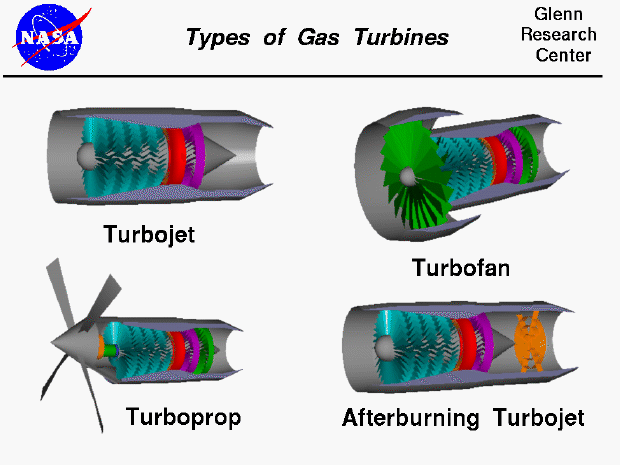

Turbojet Engines ( Part 2 : Diagrams)
------------------------------------------------------
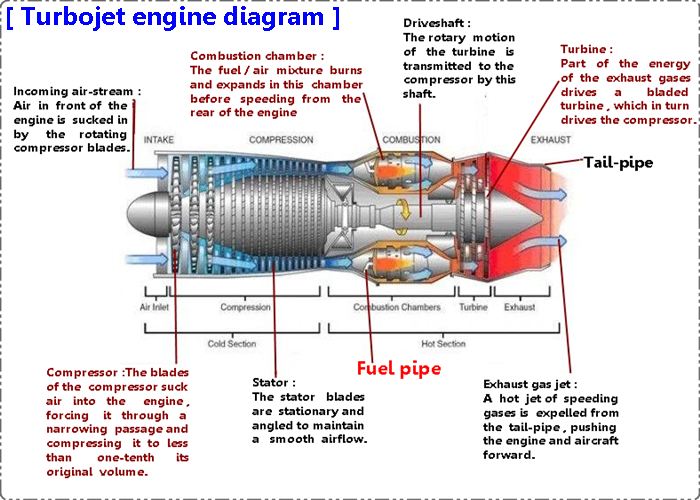

Turbofan Engines ( Part 1 )
----------------------------------------

Turbofan engines ( Part 2 )
-------------------------------------------------
Jet engines are type of internal combustion engine that have been used to propel
power boats and cars to world speed records. They are most familiar, however, as
aircraft engines. Jet engines produce power by accelerating a mass of air through
the engine . Burning fuel in the combustion chamber produces hot, expanding
exhaust gases that are blasted out of the rear of the engine. Some jet engines
also drive a propeller, while others, called turbofans, gain most of their power by
pushing a "bypass" jet of cold air around the engine.

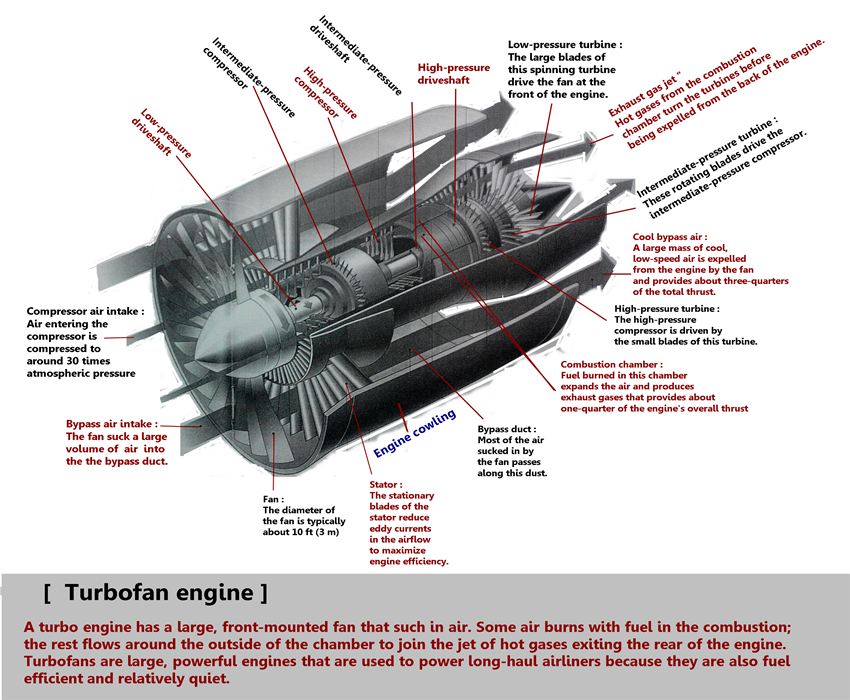
A jet engine produces thrust, force that drives the engine forward. This force is explained by the
principle of action and reaction. Hot, expanding gases are pushed out of the engine. This force ,
the action force, produces an equal and opposite reaction force from the exhaust gases to the
engine. This reaction force, called thrust, propels the engine and the attached aircraft forward.
Exactly the same principle operates when air escapes from an inflated balloon, propelling the
balloon through the air.
British engineer Dir Frank Whittle (1907 -- 1996 ) developed the jet engine in the 1930s and
his design, the turbojet , is still used today, mainly in military aircraft. Modifications of this
basic design include turboprop and turbofan engines. Turboprops couple a set of spinning
blades called a turbine to a propeller, usually at the front of the engine. The turbine uses the
exhaust jet's energy to drive the propeller, which provides most of the engine's thrust.
Turboprops are economical and suitable for small, low-speed passenger aircraft. Turbofans
use a turbine inside the engine to turn a large fan at the front that sucks in a huge volume
of air. This air is bypassed around the hot engine core and expelled at the rear, producing
most of the thrust. Turbofans are quieter but far more powerful than other jet engines and
are used in large airliners.
Helicopter (Part 1 : Body Diagram )
Helicopters are highly maneuverable aircraft that generate lift using rapidly-turning
wing-shaped rotor blades . In contrast, conventional aircraft flt by moving forward
at speed to force air over fixed wings. Since helicopters do not require forward
motion to product lift, they can take off and land vertically, hover, and fly in any
direction, even backward. The first practical helicopter was developed in 1939 by
the Russian-born engineer Igor Sikorsky (1889--1972).

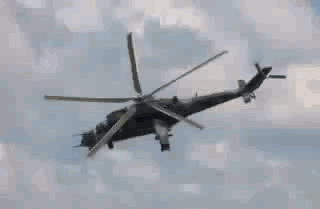

Helicopter ( Part 2 : Rotor )
Most helicopters are powered by turboshaft engines, a type of jet engine in which
a turbine turns a driveshaft that powers the rotors. In order to produce lift, each
rotor blade must be pitched, or angled, upward relative to the oncoming air. The
pilot controls the blade pitch using two controls, the collective and cyclic pitch sticks,
which are connected to swash plates on the main rotor assembly. During takeoff,
the pilot increases the pitch of all the rotor blades by the same amount with the
collective pitch stick. The throttle is opened to speed up to the rotor until the amount
of lift produced exceeds the weight of the helicopter and it rises vertically. To hover,
the pilot reduces the collective pitch so that the lift becomes equal to the weight of
the helicopter. To descend, the collective pitch is reduced until the lift is less than the
weight.
Directional flight is achieved by tilting the swash plates with the cyclic pitch control,
which alters the pitch of each blade as it rotates, so that every blade produces
greater lift at a particular point. Although vertical lift is still produced overall, thrust
is also generated in the direction that the swash plates are tilted, which causes the
helicopter to lean and fly in that direction. Further directional control is obtained by
increasing or decreasing the thrust of the tail rotor that is fitted to most helicopters.
One significant advance in helicopter design in recent years has been the development
of no-tail-rotor (NOTOR) helicopters, which use fan-driven air circulation system in place
of tail rotors.


Helicopter ( Part 3 : Forward Flight )
To fly forward , the swash plates are tilted so that the rotor blades are pitched lower
in front of the rotor assembly than behind it. This creates more lift at the back of the
helicopter than at the front, and the net force pulls the helicopter forward.
Helicopter (Part 4 : Notar System )
--------------------------------------------------
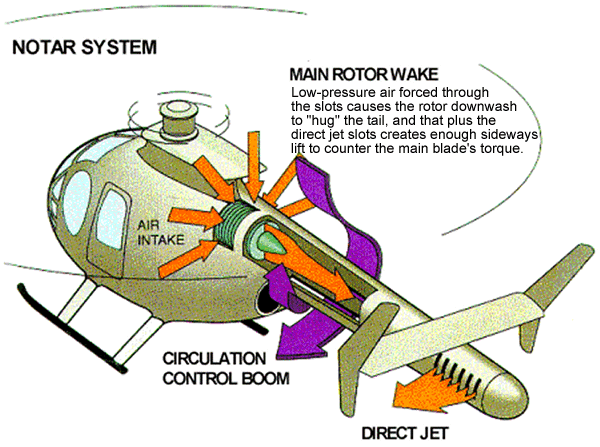
No-tail-rotor helicopters :
------------------------------------
A tail rotor not only prevents a helicopter spinning out of control, it also allows the helicopter
to be maneuvered in tight circles. It is, however, noisy and easily damaged, as well as being
hazardous to people on the ground when it is in use.
No-tail-rotor (NOTAR) helicopters provide a quieter , safer alternative. They allow a downwash
of air from the main rotors to enter the fuselage of the helicopter. This air is driven down the
tailboom by a large fan. Some of this air is forced out of slots along the side of the tailboom
and circulates around it. This creates a force that counteracts the effects of torque . Directional
control is provided by varying the amount of residual air that is expelled from the slot at the end
of the tailboom.
Helicopter ( Part 5 : Rotor Assembly )
The blades of a helicopter are rotated by one or more powered driveshafts, which are
linked to the main rotor shaft by a system of gears. The pitch (angle) of the blades is
controlled by the swash plate assembly. This consists of a non-rotating lower plate that
can be moved up and down or tilted by controls in the cockpit, and a rotating upper plate
that transfers this movement to the blades via control rods. The blades have an airfoil
section and are designed to withstand the extreme forces caused by rotation.
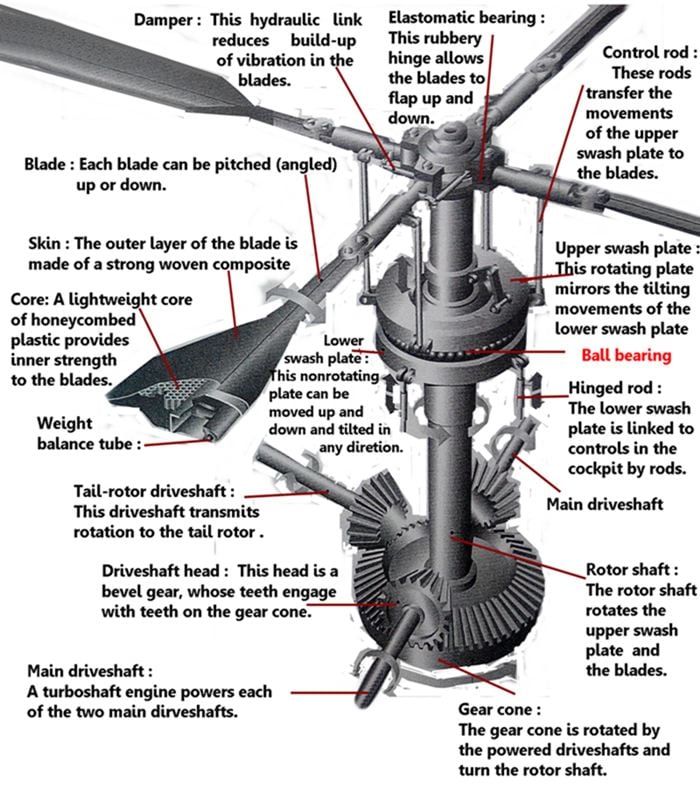
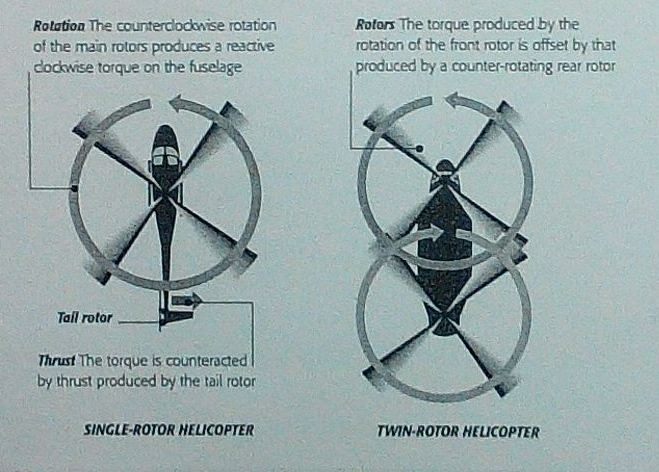
Navigation ( Part 1 )
------------------------------
Navigation is the science of fixing a vehicle's position and charting an efficient route to a
destination. Until the advent of radio, navigation was once based on maps, charts, compasses,
clocks, and the position of Sun or stars. Ships and aircraft still use these techniques, but
today a range of ground- and space-based radio navigation aids enables accurate navigation,
even in conditions of zero visibility.

Navigation ( Part 2 : Landing Systems )
-------------------------------------------------------
Radio navigation :
-------------------------
Two major radio navigation aids are LORAN and VOR .
1) LORAN (long-range navigation ) is widely used by ships and aircraft over sea.
2) VOR (Very High Frequency Omni-directional Radio Range ) beacons mark waypoints
on the air corridors (lanes) along which aircraft fly.
When landing, aircraft may use an ILS (Instrument Landing System), which enables landing
in zero visibility, or more advanced MLS (Microwave Landing System) and GPS-based systems.
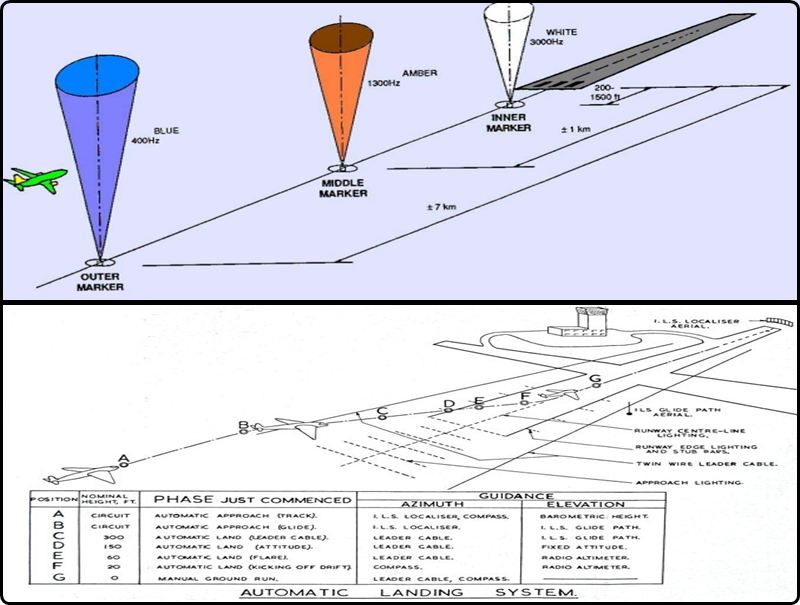
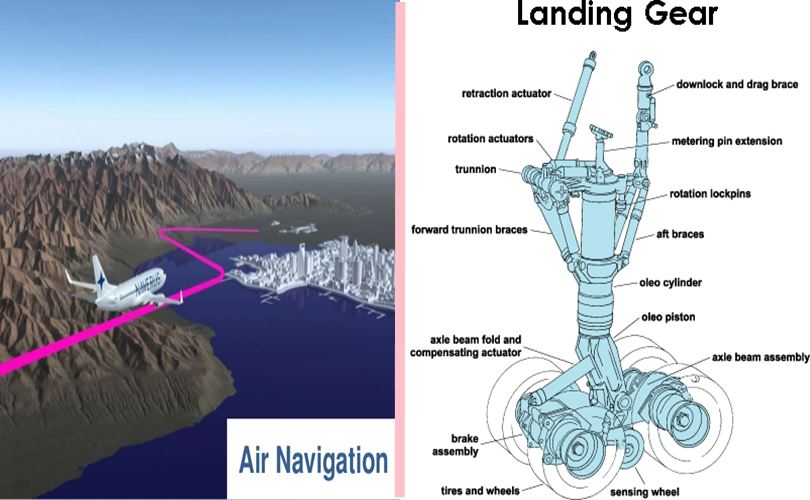
Navigation (Part 3 : Air Traffic Control )
------------------------------------------------------
As traffic has increased, navigation has become crucially linked with traffic control and the
maximization of the number of vehicles that can travel safely at the same time . Most modern
air and sea navigation system rely on various types of radio signals transmitted by fixed ground
stations. The main exceptions are the GPS (Global Positioning System), which is a very precise
satellite-based system, and IGS ( Inertial Guidance System), which is a self-contained onboard
system that works by recording every movement of a vehicle after it leaves a known starting point.
Ships and aircraft both rely on radar (radio detection and ranging), in which a transmitter sends
out radio waves and listens for echoes from other vehicles, surrounding terrain, and clouds. The
delay and intensity of the echoes enable a computer to image the surrounding area.
